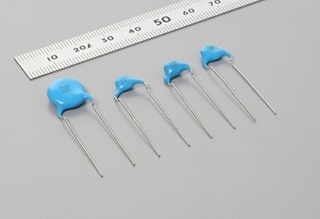source: Murata news
Murata Manufacturing Co., Ltd. has developed a new X1 class capacitor, DE1 series Type RB that has been certified for rated voltage AC760V as X1 class, as part of its DE1 series which are IEC 60384-14*1 compliant X1/Y1*2 class certified ceramic capacitors. The product contributes to size reduction and noise suppression for the power supply circuit of equipment that requires high rated voltage for industrial applications. This product starts production in December 2017 at Murata Electronics (Thailand), Ltd.
An X1 class ceramic capacitor is used for interphase with a primary power supply. This product has been certified for a high rated voltage of AC760V, so it can be used as a capacitor for interphase connection in applications where a high rated voltage is needed, such as an industrial 3-phase AC power supply or an inverter for the drive of a 3-phase motor. It can also be used as a Y1 class capacitor for connecting between an AC power line and ground. Furthermore, the product contributes to size reduction by taking advantage of the compact size provided by a ceramic capacitor, and, due to its high heat resistance, it is effective for noise suppression when placing the capacitor near a noise generating source.
Main product specification
| Item | Specification |
|---|---|
| Operating temperature range | -40 to 125℃ |
| Rated Voltage | X1:AC760V (r.m.s.),Y1:AC500V (r.m.s) |
| Capacitance Range | 10 to 4700pF |
| Certification Standards Met | UL(UL 60384-14),ENEC(EN60384-14),CQC(IEC60384-14) |
Explanation of terms
*1 IEC 60384-14 : An international standard that regulates the withstanding pressure performance and combustion resistance of capacitors connected to commercial power supplies, from the standpoint of preventing fires and electric shock from electrical leakage.
*2 X1/Y1 : A subclass of capacitors classified by insulation type in the standard mentioned above. Subclass X1/Y1 capacitors have the highest performance requirements.






























